AWS-QwikLabs : ElasticSearch Service (ES)
In this post, we'll deploy an ElasticSearch Service (ES), a CloudWatch Log Group that subscribes to the ElasticSearch Service, and monitor the service via Kibana.
This post is based on Introduction to Amazon ElasticSearch Service.
ElasticSearch is an open-source search and analytics engine for text search and log / clickstream analytics.
Amazon ES provides built-in integration with LogStash and Kibana. The LogStash is a data pipeline that processes and events data, and load them into ElasticSearch. Kibana is a visualization platform that helps us understand our data from the ElasticSearch.
ES domain comprises ES cluster, load-balancing, monitoring, and etc.
A cluster is a collection of data nodes (instances), optionally, including master node.
Click "Create a new domain", and then config:
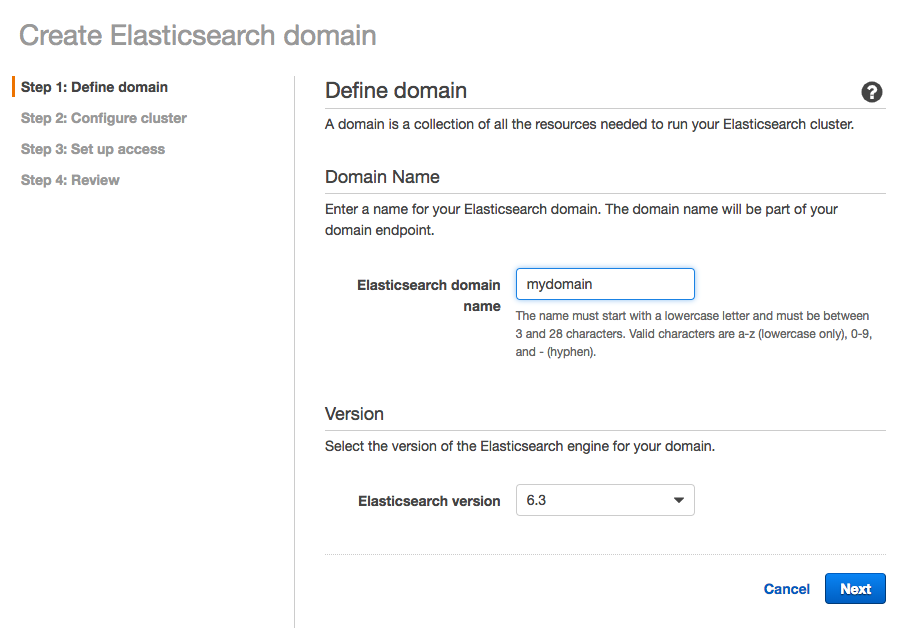
Click "Next".
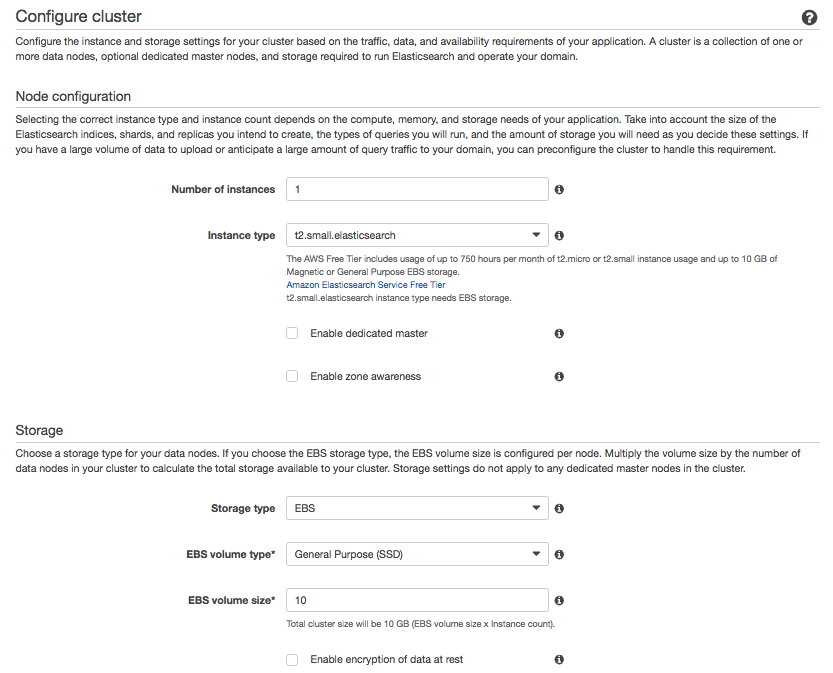
Click "Next".
In the "Network configuration" section, select "Public access":
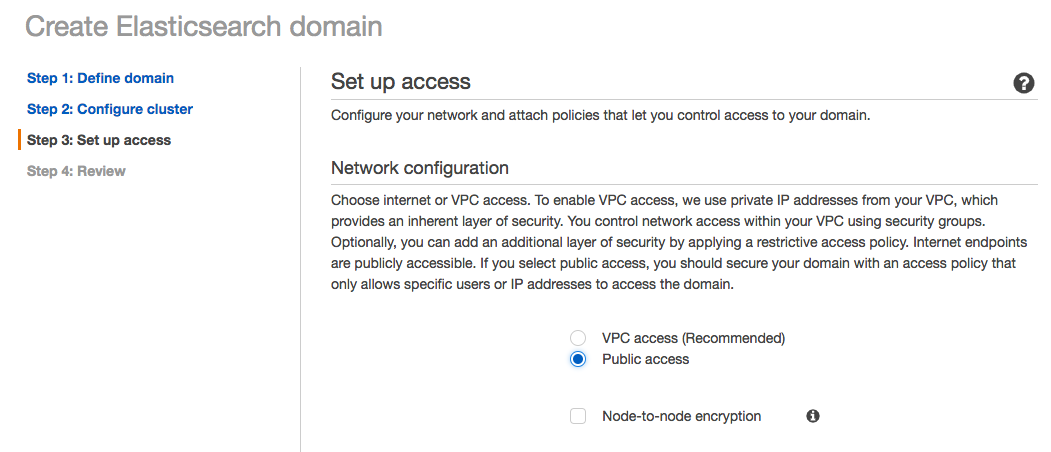
Select "Allow open access to the domain":
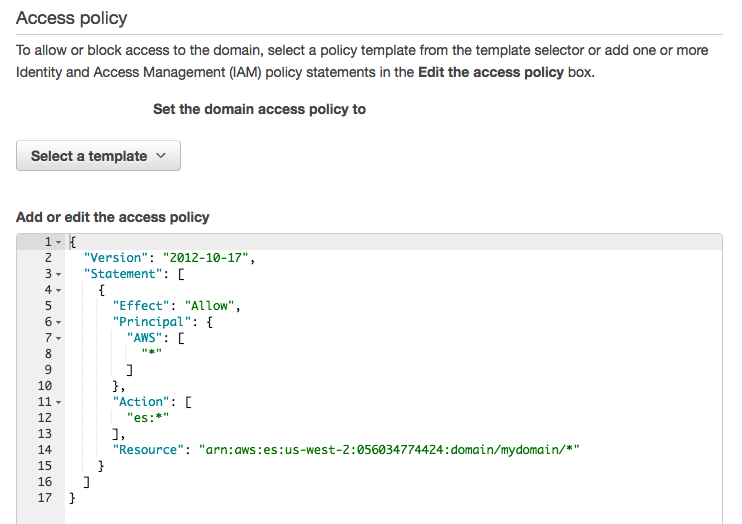
Note that it's allowing all ES actions (ES:*) to anybody (Principal = *).
Click "Next" and then "Confirm".
It may take 10 minutes before it's fully deployed.
The CloudTrail records API calls made from our AWS account, and it delivers the logs to our S3 bucket. We can use the CloudTrail to track changes made to AWS resources.
In this post, we use it to get logs from ES API calls.
We want to capture usages of ES services within our account by creating CloudTrail Log Group.
Let's go to "CloudTrail" service and click "Trail". Select the trail in the "Oregon" region.

Then, scroll down to "CloudWatch Logs" section:

Click "Configure":

Click "Continue":
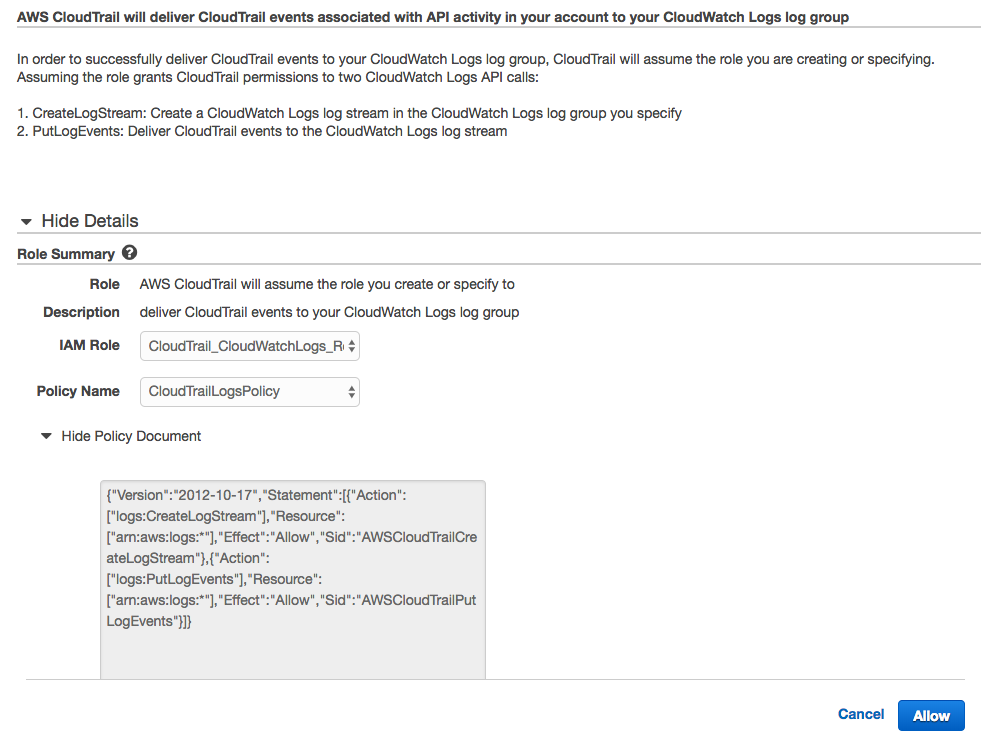
Click "Allow".
Now, we need to configure the CloudWatch Logs to stream the CloudTrail data to the ElasticSearch cluster.
Go to "ElasticSearch Service" console.
Below "Domain", click "mydomain":

Wait for the "Domain status" to become "Active".
Once checked the ES domain is "Active", let's go to the "CloudWatch" service.
Click "Logs" in the left pane, then we'll see "CloudTrail Log Group, "esLogGroup". Select it:
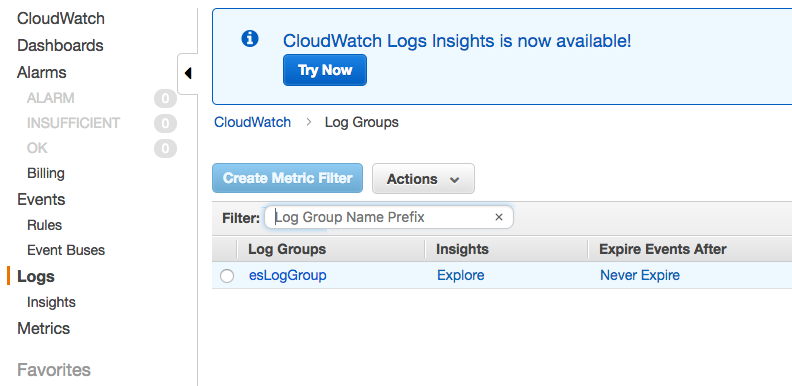
In the "Actions" menu, select "Stream to Amazon ElasticSearch":
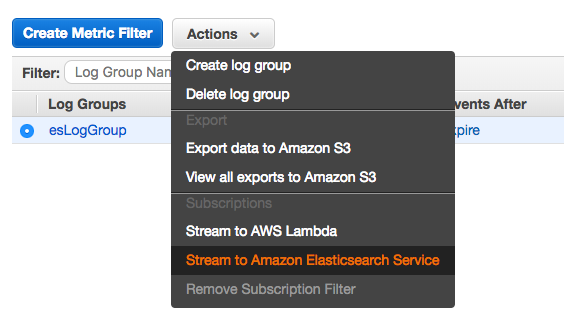
From the "Amazon ES cluster" drop-down list, select "mydomain".
From the "Lambda IAM Execution Role" drop-down list, select "lambda_basic_execution".
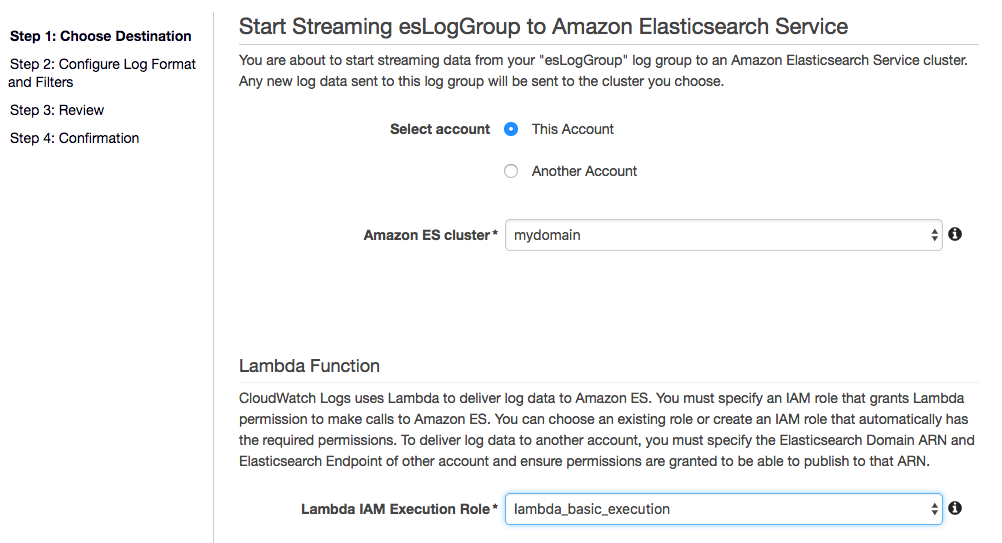
Now, let's configure log format. Select "Test Pattern", and click "Next":
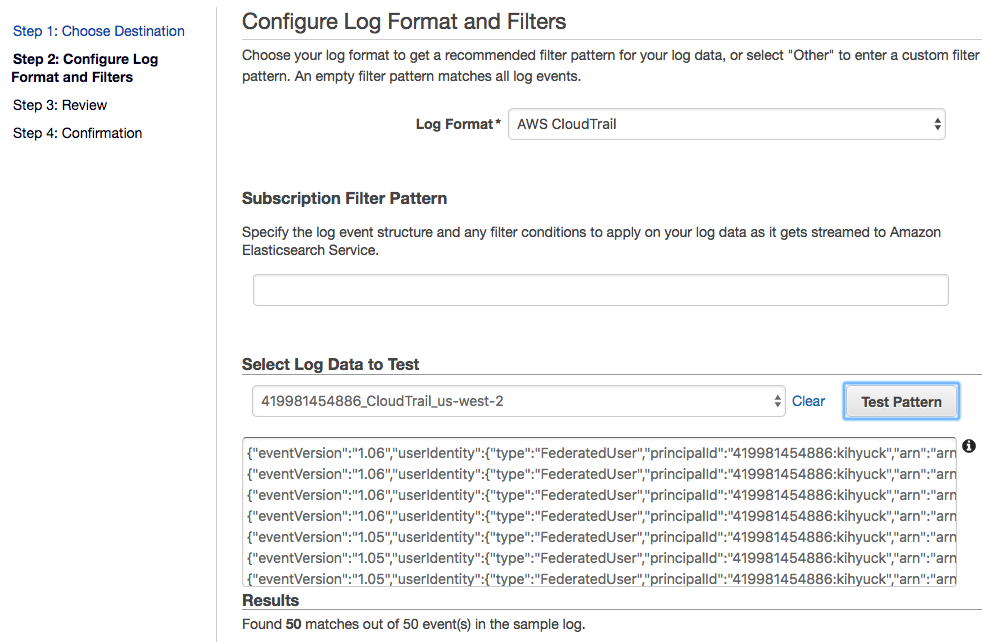
Click "Next", and "Start Streaming"
Click "Kibana" link under "ElasticSearch Service/mydomain":
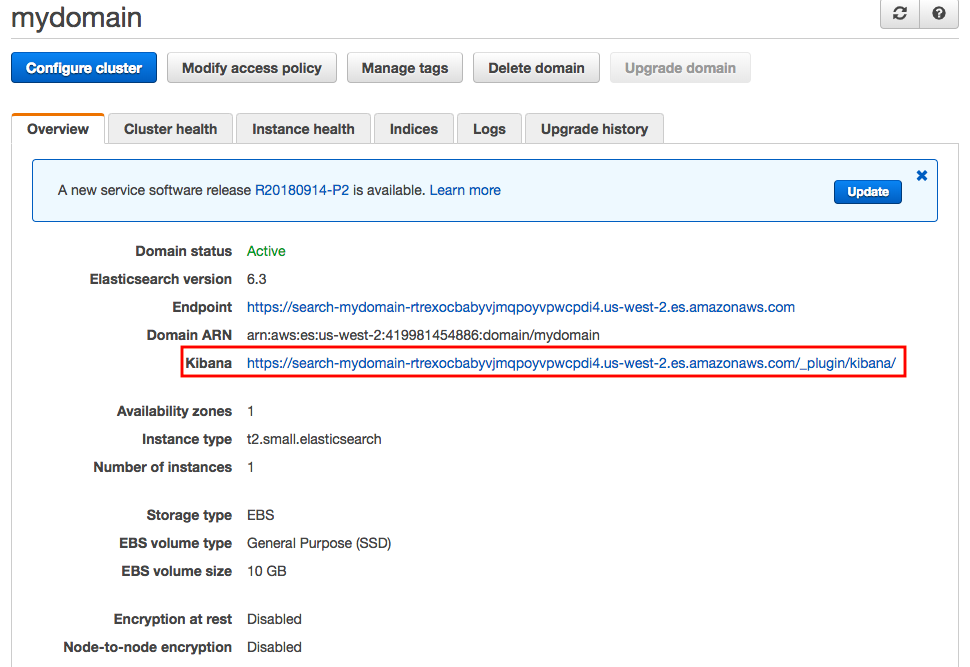
Click "Visualize" from the navigation pane in the left:
In the "Index pattern" field", enter "*":
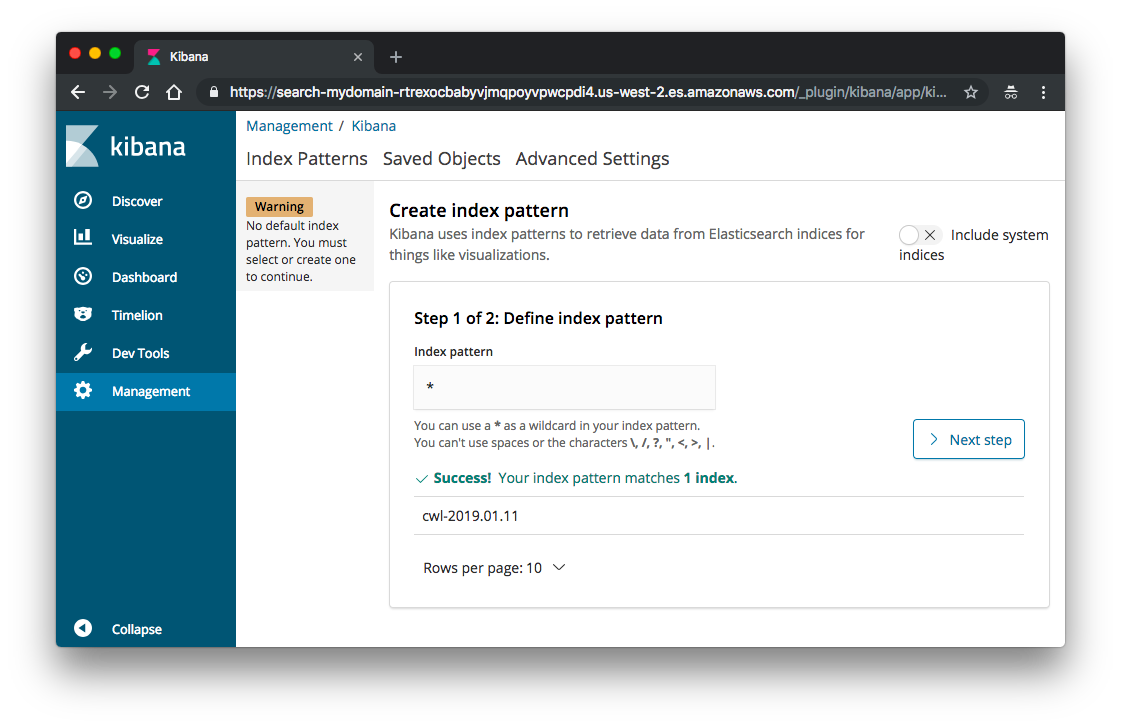
Click "Next step":
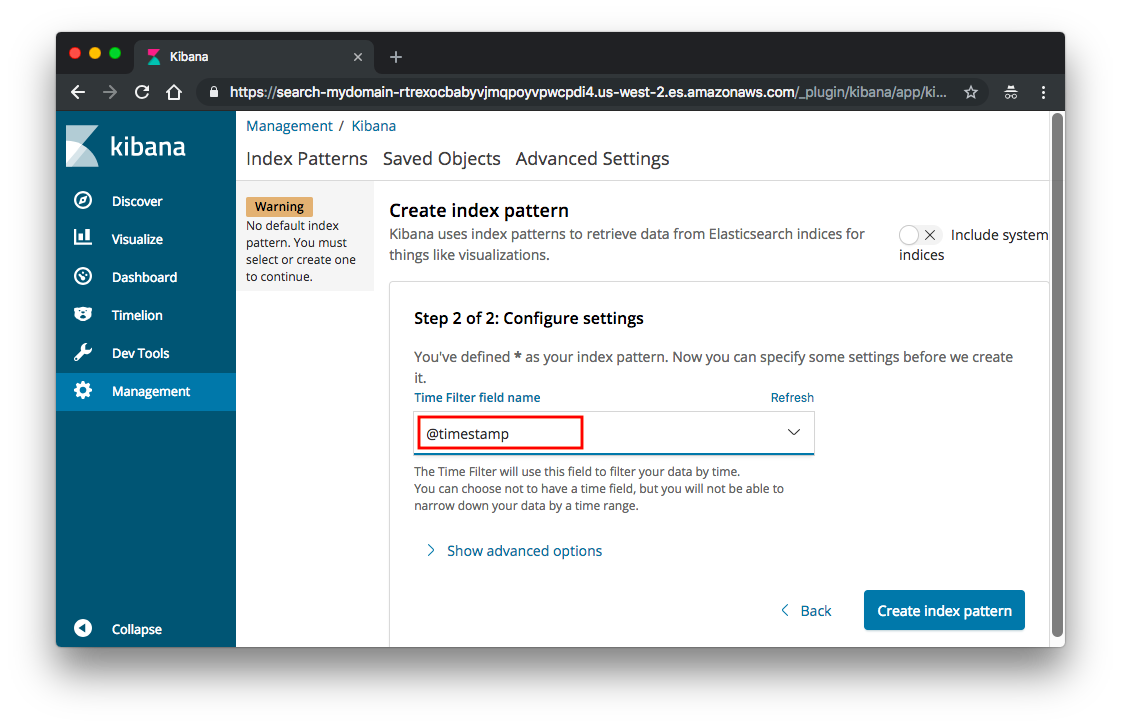
Click "Create index pattern":
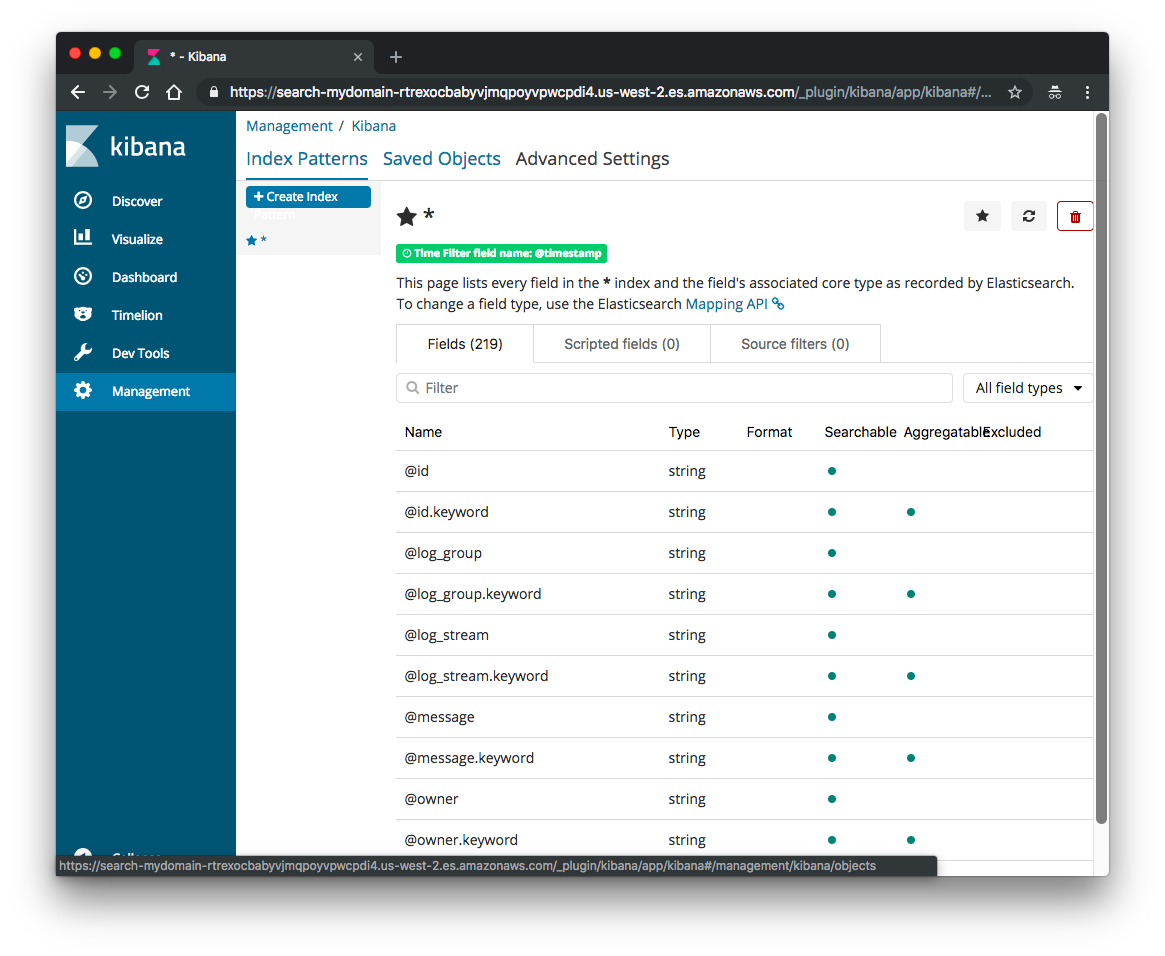
In the left navigation pane, click "Discover":
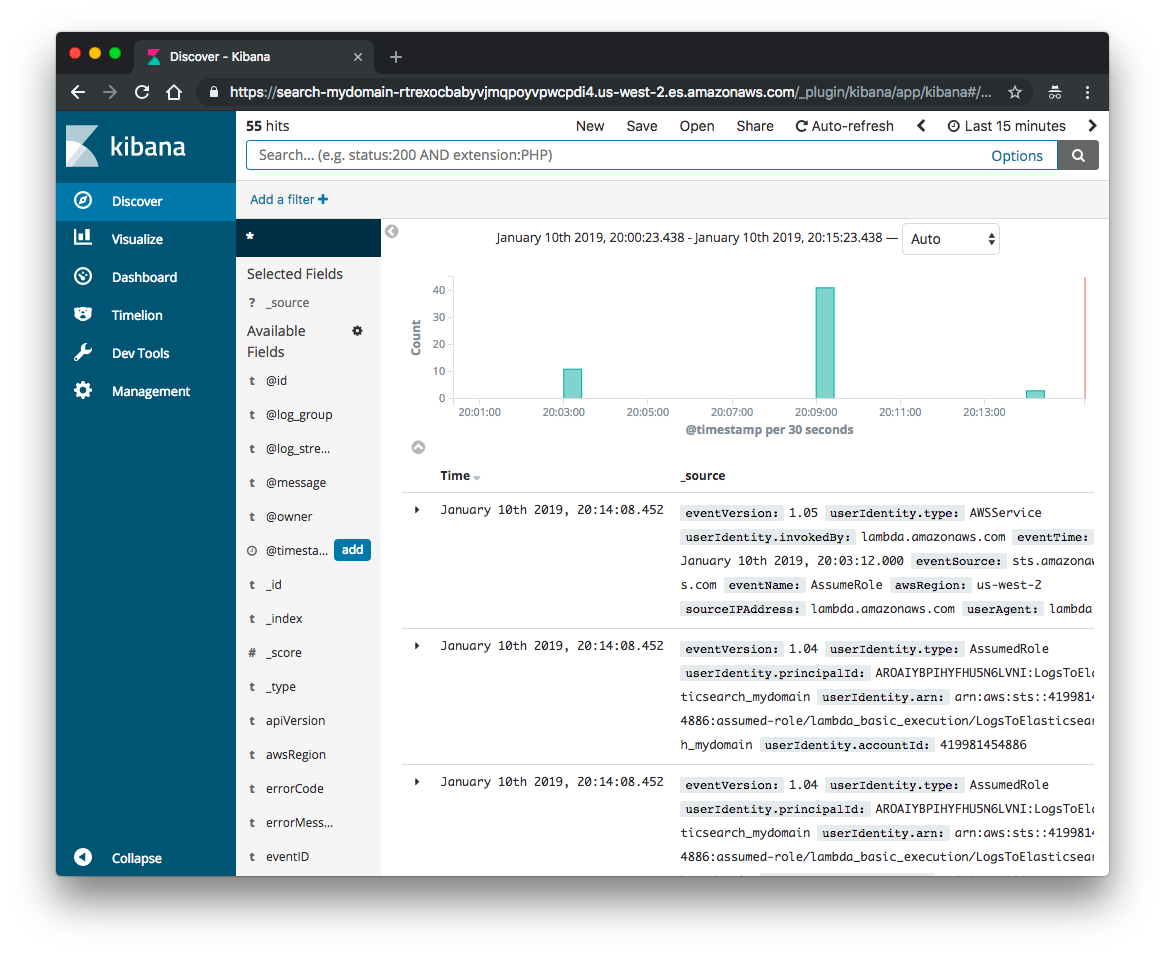
We can change a time-interval. Switch it to " Last 30 minutes" in the top-right of the screen:

In the left navigation pane, click "Visualize":
Click "Create a visualization", and select "Line" chart:
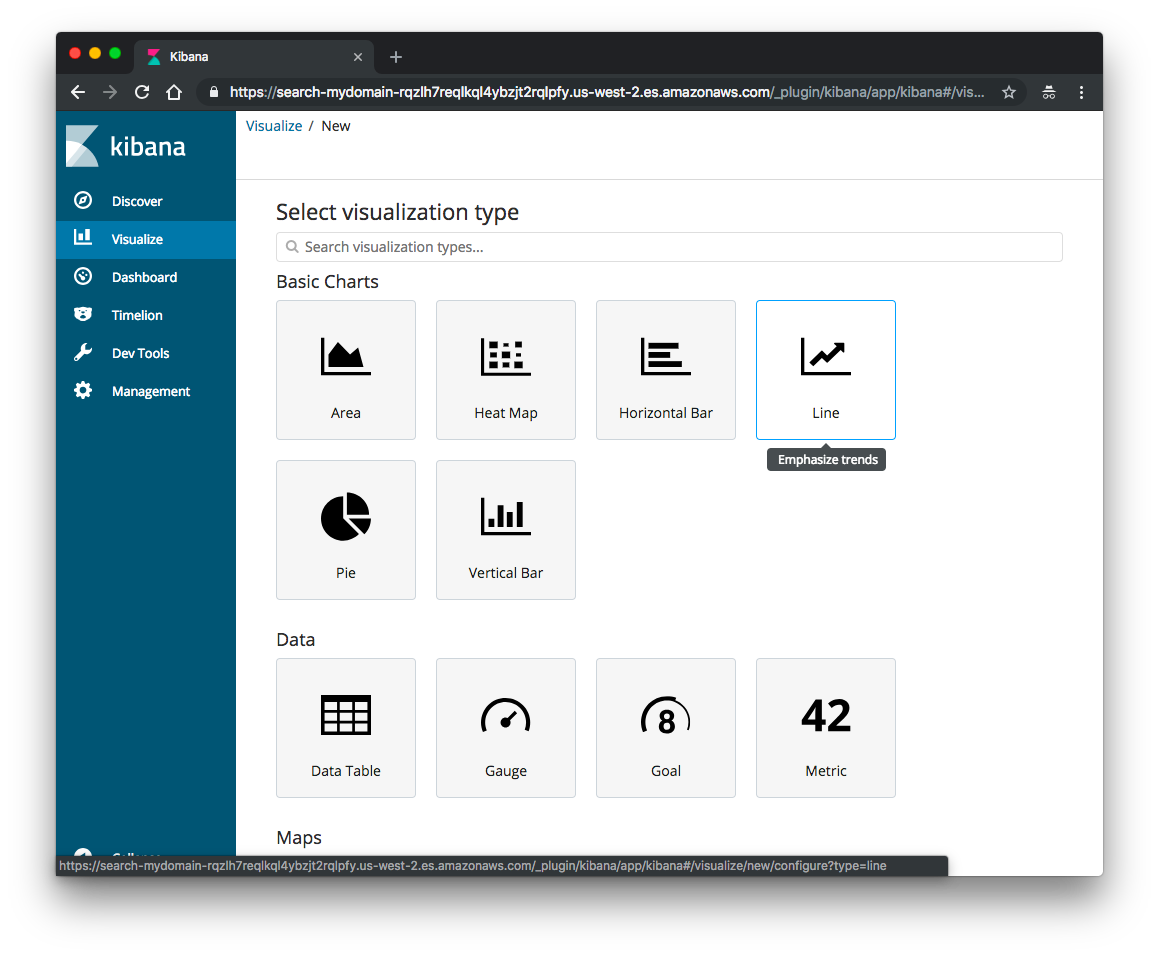
In the "From a New Search, Select Index:" column, select '*'. Under "Select Bucket type", select "X-Axis":
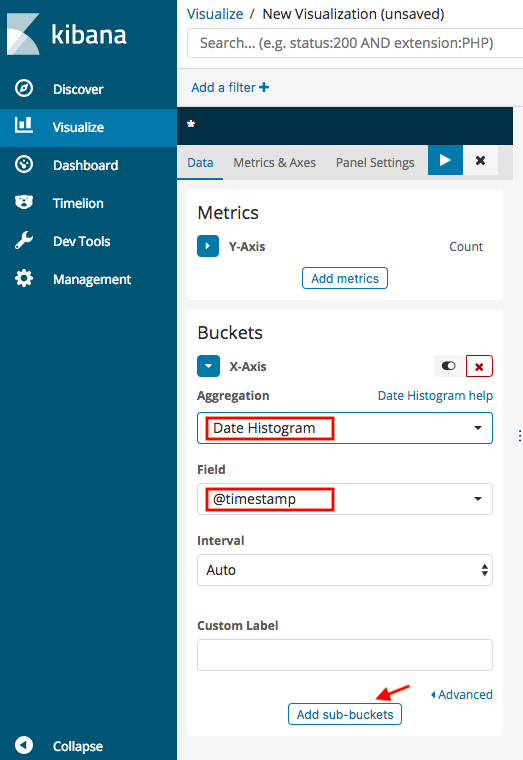
Click "Add sub-buckets" and "Split Series":
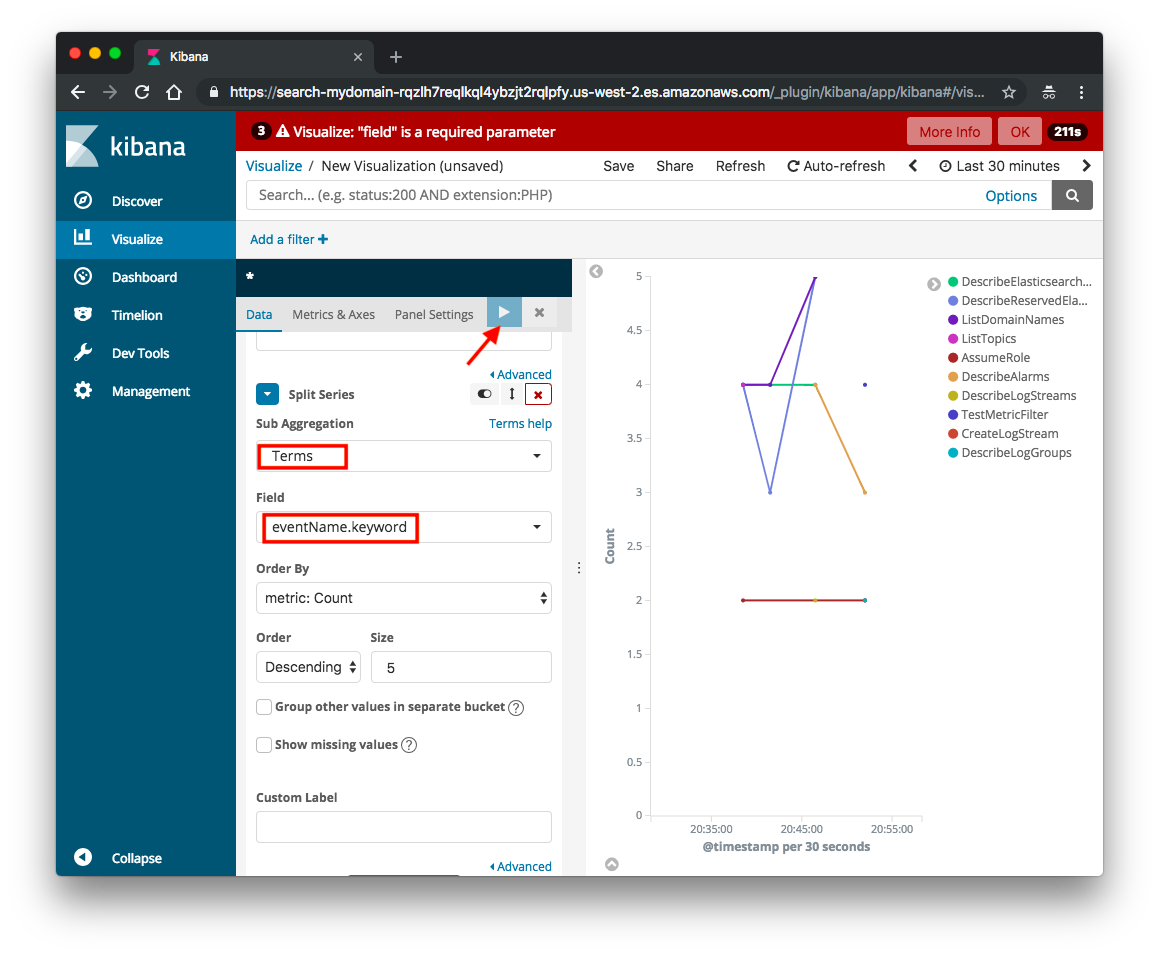
Click the Play button to view the chart.
Go to "ElasticSearch Service", click the "Indices" tab:

AWS (Amazon Web Services)
- AWS : EKS (Elastic Container Service for Kubernetes)
- AWS : Creating a snapshot (cloning an image)
- AWS : Attaching Amazon EBS volume to an instance
- AWS : Adding swap space to an attached volume via mkswap and swapon
- AWS : Creating an EC2 instance and attaching Amazon EBS volume to the instance using Python boto module with User data
- AWS : Creating an instance to a new region by copying an AMI
- AWS : S3 (Simple Storage Service) 1
- AWS : S3 (Simple Storage Service) 2 - Creating and Deleting a Bucket
- AWS : S3 (Simple Storage Service) 3 - Bucket Versioning
- AWS : S3 (Simple Storage Service) 4 - Uploading a large file
- AWS : S3 (Simple Storage Service) 5 - Uploading folders/files recursively
- AWS : S3 (Simple Storage Service) 6 - Bucket Policy for File/Folder View/Download
- AWS : S3 (Simple Storage Service) 7 - How to Copy or Move Objects from one region to another
- AWS : S3 (Simple Storage Service) 8 - Archiving S3 Data to Glacier
- AWS : Creating a CloudFront distribution with an Amazon S3 origin
- AWS : Creating VPC with CloudFormation
- AWS : WAF (Web Application Firewall) with preconfigured CloudFormation template and Web ACL for CloudFront distribution
- AWS : CloudWatch & Logs with Lambda Function / S3
- AWS : Lambda Serverless Computing with EC2, CloudWatch Alarm, SNS
- AWS : Lambda and SNS - cross account
- AWS : CLI (Command Line Interface)
- AWS : CLI (ECS with ALB & autoscaling)
- AWS : ECS with cloudformation and json task definition
- AWS Application Load Balancer (ALB) and ECS with Flask app
- AWS : Load Balancing with HAProxy (High Availability Proxy)
- AWS : VirtualBox on EC2
- AWS : NTP setup on EC2
- AWS: jq with AWS
- AWS & OpenSSL : Creating / Installing a Server SSL Certificate
- AWS : OpenVPN Access Server 2 Install
- AWS : VPC (Virtual Private Cloud) 1 - netmask, subnets, default gateway, and CIDR
- AWS : VPC (Virtual Private Cloud) 2 - VPC Wizard
- AWS : VPC (Virtual Private Cloud) 3 - VPC Wizard with NAT
- DevOps / Sys Admin Q & A (VI) - AWS VPC setup (public/private subnets with NAT)
- AWS - OpenVPN Protocols : PPTP, L2TP/IPsec, and OpenVPN
- AWS : Autoscaling group (ASG)
- AWS : Setting up Autoscaling Alarms and Notifications via CLI and Cloudformation
- AWS : Adding a SSH User Account on Linux Instance
- AWS : Windows Servers - Remote Desktop Connections using RDP
- AWS : Scheduled stopping and starting an instance - python & cron
- AWS : Detecting stopped instance and sending an alert email using Mandrill smtp
- AWS : Elastic Beanstalk with NodeJS
- AWS : Elastic Beanstalk Inplace/Rolling Blue/Green Deploy
- AWS : Identity and Access Management (IAM) Roles for Amazon EC2
- AWS : Identity and Access Management (IAM) Policies, sts AssumeRole, and delegate access across AWS accounts
- AWS : Identity and Access Management (IAM) sts assume role via aws cli2
- AWS : Creating IAM Roles and associating them with EC2 Instances in CloudFormation
- AWS Identity and Access Management (IAM) Roles, SSO(Single Sign On), SAML(Security Assertion Markup Language), IdP(identity provider), STS(Security Token Service), and ADFS(Active Directory Federation Services)
- AWS : Amazon Route 53
- AWS : Amazon Route 53 - DNS (Domain Name Server) setup
- AWS : Amazon Route 53 - subdomain setup and virtual host on Nginx
- AWS Amazon Route 53 : Private Hosted Zone
- AWS : SNS (Simple Notification Service) example with ELB and CloudWatch
- AWS : Lambda with AWS CloudTrail
- AWS : SQS (Simple Queue Service) with NodeJS and AWS SDK
- AWS : Redshift data warehouse
- AWS : CloudFormation
- AWS : CloudFormation Bootstrap UserData/Metadata
- AWS : CloudFormation - Creating an ASG with rolling update
- AWS : Cloudformation Cross-stack reference
- AWS : OpsWorks
- AWS : Network Load Balancer (NLB) with Autoscaling group (ASG)
- AWS CodeDeploy : Deploy an Application from GitHub
- AWS EC2 Container Service (ECS)
- AWS EC2 Container Service (ECS) II
- AWS Hello World Lambda Function
- AWS Lambda Function Q & A
- AWS Node.js Lambda Function & API Gateway
- AWS API Gateway endpoint invoking Lambda function
- AWS API Gateway invoking Lambda function with Terraform
- AWS API Gateway invoking Lambda function with Terraform - Lambda Container
- Amazon Kinesis Streams
- AWS: Kinesis Data Firehose with Lambda and ElasticSearch
- Amazon DynamoDB
- Amazon DynamoDB with Lambda and CloudWatch
- Loading DynamoDB stream to AWS Elasticsearch service with Lambda
- Amazon ML (Machine Learning)
- Simple Systems Manager (SSM)
- AWS : RDS Connecting to a DB Instance Running the SQL Server Database Engine
- AWS : RDS Importing and Exporting SQL Server Data
- AWS : RDS PostgreSQL & pgAdmin III
- AWS : RDS PostgreSQL 2 - Creating/Deleting a Table
- AWS : MySQL Replication : Master-slave
- AWS : MySQL backup & restore
- AWS RDS : Cross-Region Read Replicas for MySQL and Snapshots for PostgreSQL
- AWS : Restoring Postgres on EC2 instance from S3 backup
- AWS : Q & A
- AWS : Security
- AWS : Security groups vs. network ACLs
- AWS : Scaling-Up
- AWS : Networking
- AWS : Single Sign-on (SSO) with Okta
- AWS : JIT (Just-in-Time) with Okta
Ph.D. / Golden Gate Ave, San Francisco / Seoul National Univ / Carnegie Mellon / UC Berkeley / DevOps / Deep Learning / Visualization